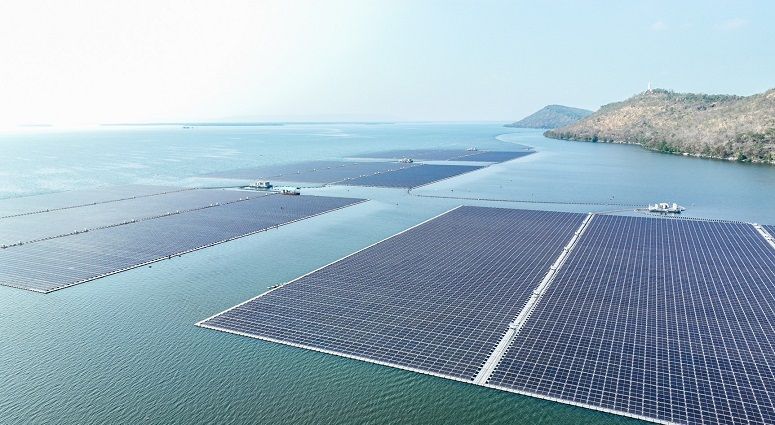Two recent hybrid hydro-floating solar energy projects jointly built by Chinese and Thai companies showcase an innovative blend of solar and hydroelectric technologies to optimize both environmental and operational efficiencies.
- The Sirindhorn Dam hybrid power project in Ubon Ratchathani province in northeastern Thailand commenced commercial operation in October 2021. Project harnesses the combined capacity of 81 MW, comprising 36 MW from hydro and 45 MW from floating solar panels. Jointly built by China Energy Engineering, Chinese companies JA Solar Holdings and Sungrow Power Supply in conjunction withThailand’s B.Grimm Power Plc (BGRIM).
- The Ubolratana Dam hybrid power project in Khon Kaen province in northeastern Thailand commenced commercial operation in March 2024. Project harnesses 24 MW that combines solar power and hydropower along with a battery energy storage system (BESS) to help stabilize electricity generation from renewable energy. Jointly built by Chinese state-owned energy company Dongfang Electric International Corporation (DEC) and the Thai MPD Consortium (Mitr Phol Energy Services Co Ltd; PEA ENCOM International Co Ltd).
The Electricity Generating Authority of Thailand (EGAT) plans to significantly increase hybrid hydro-floating solar farms by 2037 under Thailand’s Power Development Plan. EGAT will develop a total of 16 floating solar projects at nine existing hydro dams which it operates with a a total installed capacity of 2,725 MW.
The benefits of hybrid floating solar-hydro power projects
- The following is an edited extract from an article by Dr Emanuele Quaranta that appeared in Solar Power World.
Background
Hydropower and solar power plants were developed separately in the past. Recently, hydro and solar plants have started to merge into photovoltaic-hydropower hybrid plants, where floating solar panels are installed on the water surface of hydropower reservoirs and/or on the dam surface. This represents a cost-effective strategy for allocating new PV plants without occupying natural lands, protecting dams from insulation and increasing hydropower generation by reducing evaporation losses.
Globally, hydropower represents the largest share of renewable electricity generation, with almost 1,200 GW of installed capacity, where 328 GW are run-of-the-river plants (e.g., hydropower plants without storage reservoirs, or with very small ones). Hydropower is a renewable energy source with benefits for flood control, water management, promotion of leisure activities and stabilization of the electric grid.
However, a major loss in hydropower plants is the evaporation of water from reservoirs because the evaporated water cannot be exploited by the turbine to generate energy. Meanwhile, PV plants have grown exponentially since 2010, with a total installed capacity worldwide of about 400 GW that is expected to grow in the next decades.
Some of the biggest challenges, though, are that solar projects require large areas, and the warming of panels reduces their efficiency.
Photovoltaic-hydropower hybrid plants
In photovoltaic-hydropower hybrid plants, PV panels are incorporated into the hydro plant two main ways: i
- installation of PV panels on the downstream face of the dam, an option only possible in certain plants where the face slope of the dam is below 40°; or
- floating PV panels on the water surface of the hydropower reservoir.
In hybrid systems, several benefits are achieved with respect to the independent operation of the solar and hydro plants. In general, hydro plants are easy to access and already grid-connected, thus the installation of PV panels requires less work and infrastructure.
In the case of solar panels floating on hydropower reservoirs, the benefits are as follows:
- Land use is minimized
- The cooling effect provided by water below the panels increases panel efficiency
- The shading provided by PV panels on the water reduces algae growth and water evaporation, improving hydro energy generation and water quality
- The water surface provides areas free of shading objects along with higher sunlight reflection, improving PV generation
In the case where PV panels are on physically mounted on the dam structure, the benefits are as follows:
- PV panels protect the dam surface from direct solar radiation that may negatively affect the stability of the dam itself, reducing thermal excursion of the dam surface and increasing dam durability
- PV panels are installed on an existing structure (the dam surface), reducing land use
- Energy generated by PV can be used for pumping in pumped-storage hydropower plants
- PV panels are mounted on an inclined area, minimizing the distance required between two panels with respect to an analogous installation on a flat area, thus increasing solar energy generation
Floating panels can increase the capacity factor of a hydropower plant by 50% to 100% (the capacity factor of the hydro plant is the ratio of total generated energy to the maximum energy than can be generated if the hydro plant always worked at its maximum installed power capacity). Floating panels can gain 7% to 14% more energy than a land installation due to the reduction of temperature.
However, floating PV has an important limit: It cannot resist strong wind gusts, necessitating a very large number of mooring points in order for it to remain intact. The solution is based on a more robust design where rafts are built with polyethylene pipes and steel beams supported by 20 to 24 panels. This approach has been shown to resist damage by wind up to 140 km per hour.
Aerial view of hydro-floating solar hybrid project at Sirindhorn Dam in Thailand.
Sources:
- Solar Quater, May 25, 2024. https://solarquarter.com/2024/05/25/thailands-sirindhorn-dam-leads-renewable-innovation-with-hydro-floating-solar-hybrid-project-case-study/
- Power Technology, July 21, 2024. https://www.power-technology.com/data-insights/power-plant-profile-sirindhorn-dam-hybrid-solar-pv-park-thailand/
- CGTN, Mar 6, 2024. https://news.cgtn.com/news/2024-03-06/China-Thailand-hydro-floating-solar-project-starts-commercial-use-1rKft1xhd6M/p.html
- Solar Power World, May 28, 2020. https://www.solarpowerworldonline.com/2020/05/floating-solar-hydropower-hybrid-projects-can-benefit-both-technologies/
